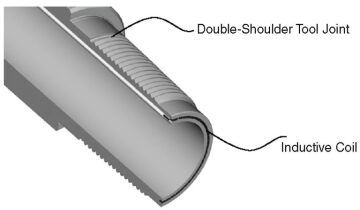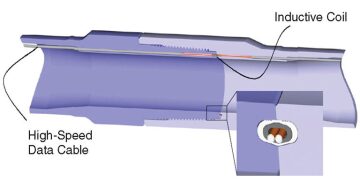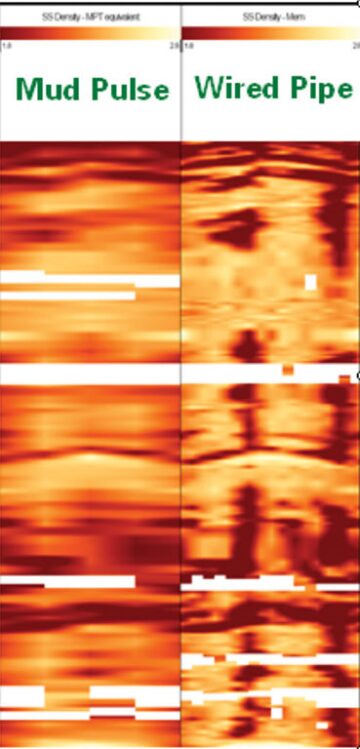Field trials were conducted by BP on the commercial version of wired pipe with a comprehensive suite of logging-while-drilling (LWD) tools, measurement-while-drilling (MWD) functionality, and rotary-steerable- capability on two Wyoming wells in 2007. Since then, BP has deployed wired pipe commercially in more than 14 wells at four additional locations (Trinidad, North Sea, Colombia, and deepwater Gulf of Mexico), representing a good cross section of drilling conditions and challenges.
Basics of How Wired Pipe Works
Wired drillpipe incorporates a section of coaxial cable in each joint. The cable passes through a gun-drilled hole in the connection on each end of the joint. Between connections, the cable is encased in a strong stainless-steel sheath, which is held in tension within the inner diameter of the pipe adjacent to, but not bonded to, the inner wall. Fig. 1 and Fig. 2 show schematics of the wired pipe.


Inductive coupling enables the signal to pass from one joint to the next, through ferrous coils that are embedded in the pin end of one joint of pipe and the opposing box end of the subsequent joint of pipe. These coils come very close to each other when the connection is made up, but, because the coupling is inductive, they do not need to touch, and insulating material such as pipe dope does not block the signal. However, over many joints of pipe, there is a loss of signal strength, and, for this reason, a battery-powered booster sub is deployed approximately every 1,500 ft. The booster assemblies also provide housing and a connection point for along-string measurements. On the bottomhole-assembly (BHA) end of the drillstring, wired pipe connects to the measurements providers and steering assembly through an interface sub, enabling two-way communication to the network, usually provided by the LWD provider. At the top of the drillstring, the network is connected to surface servers by a data swivel housed in the top drive.
Wired-Pipe-Enabled Applications
Real-Time Imaging. Several different LWD imaging tools are commercially available today. Two types of tools that have been run with wired pipe are the LWD azimuthal density imaging tool and LWD resistivity imaging.
Azimuthal density tools are not designed primarily for imaging but rather to make a density measurement (and, primarily for this purpose, they are run almost routinely in most reservoir sections and often in a section or two above the reservoir in high-value, typically offshore, developments). However, the fact that the tool rotates enables the density measurements to be binned into 16 sectors around the circumference of the hole to make a density image. Depending on rate of penetration (and tool setup), an azimuthal density measurement will be made every few inches. Hence, an image (though rather low in resolution compared with that from tools designed specifically for imaging) is created. Although such images are not particularly useful for detailed geological interpretation, it turns out that, because of the typical density contrast between mud and rock, they are very useful for measuring hole-size variations and, thus, for detecting hole-stability or -geometry issues.
Wellbore Stability and Hole-Quality Management. The potential of directly seeing the size and shape of the hole as it is drilled has long been recognized as being a very powerful application.
The use of azimuthal density images for detecting and diagnosing wellbore-instability problems has been developing in the industry over the last 10 years or so. However, it has also been recognized that much of this work has been performed from the memory data of the tool that are downloaded when the BHA is at surface. Most of the measurements made by the LWD density tools have typically not been transmitted to the surface while drilling. This is primarily because of the bandwidth restrictions of mud-pulse telemetry. With typically available mud-pulse bandwidth, either no image is sent to surface or a compressed and low-resolution image is sent to surface. Such images are generally not adequate for interpreting wellbore-stability issues. Wired pipe, on the other hand, enables all the downhole data (normally recorded to memory) to be written to the network and sent to surface in real time. Also, every time the tool passes an interval and is rotating (with the tool on), an image is made. Therefore, multiple repeat-pass images of a hole section can be made, which turns out to be critical in understanding many cases of wellbore instability.
Fig. 3 shows a comparison of the wired-pipe image and the mud-pulse image from one of the field-trial wells. The borehole breakout clearly seen in the wired-pipe image is obscured in the mud-pulse image because the density values are averaged across larger sectors. It should be noted that, although the mud-pulse image is typical of the quality normally pulsed to surface (if an image is pulsed at all), it is possible to set up the mud-pulse frames to send a higher-quality image, but that would likely mean that other data that are normally pulsed would have to be dropped.

The use of multiple real-time, memory-quality LWD images and their time-lapse repeat passes has significantly improved the ability for early detection of wellbore instability, which allows the appropriate remedial action to be taken early enough to avoid loss of the hole section.
Detailed Real-Time Geological and Geomechanical Interpretations. High-resolution resistivity images are restricted to water-based mud and only some hole sizes and are not commonly run in LWD. However, as water-based muds improve, the value provided by the high-resolution image may, in some cases, outweigh the other considerations in the mud-selection process. The ability to be able to see these images in real time while drilling could have significant implications for accurate well placement in complex geological settings.
Along-String Sensors. Wired pipe requires signal-booster assemblies to be positioned in the drillstring approximately every 1,500 ft. This provides an opportunity to make along-string measurements.
Hole Cleaning and Solids Transport. Changes in annular-pressure data are a key proxy for the solids loading of the wellbore annulus. In conventional drilling operations, these data are recorded only at one place, in the BHA at the bottom of the drillstring. The deployment of annular-pressure measurements along the drillstring allows measurements to be taken throughout the wellbore annulus, providing much-more-detailed information about the overall state of solids transport throughout the well. By examining pressure responses on individual sensors, it is possible to determine where in the wellbore solids are accumulating and whether material picked up downhole is being transported back to surface.
Locating Downhole Events. The deployment of multiple sensors of any description along the drillstring allows for much greater accuracy in determining the location of downhole events. In the case of annular-pressure data, simply by looking at which sensors are showing evidence of a given event, such as a packoff, the location of the event downhole can be determined.
Pumps-Off Data Availability. One of the more significant benefits of wired pipe is not so much the volume of data that it can provide but the fact that it can provide downhole data even when pumps are off. It is a major limitation of mud-pulse telemetry that, when pumps are off, communication with downhole is lost. Because the booster subs are battery powered, communication continues regardless of the state of the pumps.
Operational Issues
Deploying and running wired pipe should be viewed as a project, not as a call-out service. It is a project in which the operator, the LWD provider, the rig contractor, and other third parties whose equipment is affected all have to be fully involved and aligned. While the benefits of wired pipe are great, the effort required to achieve a successful deployment is not insignificant.
Equipment Modifications. Modifications to the topdrive are likely to be the biggest equipment-related issue in a deployment. The topdrive must accommodate the data swivel. This is the component that takes data from the box end of the top-most joint of pipe, through a rotating connection, to a cable that is routed to the server. The data swivel is typically 1–2 ft long. Ideally, the data swivel is installed on the bottom of the topdrive, where the saver sub usually sits. In this case, no other components of the topdrive have to be wired. However, with the topdrives used offshore on BP deployments, this was generally not possible, and more-extensive modifications had to be made. When the swivel is installed higher in the topdrive assembly, any components that sit beneath it also have to be wired. Fig. 4 above shows an example of one of the topdrives with the data swivel installed.
The data cable from the data swivel is routed through the service bundle. Because the data swivel can move, there is a risk of severing this data cable. In most cases, a tether is needed to limit this movement.
Reliability While Running Wired Pipe. Of the five locations where wired pipe has been deployed within BP, four of them are considered to have been successful in the sense that the technology worked. The exception was the North Sea deployment, where an older design of wired pipe was used, which proved unreliable because of a fundamental design issue. Other than the North Sea deployment, the experience with wired pipe has been that it generally works if it is handled and maintained properly.
In the authors’ experience, a new string of wired pipe was generally reliable. Network uptimes of 90–100% were generally noted. However, as the equipment continued to be used, it was generally found that reliability decreased. In other words, durability became the issue. Most of the reliability issues were associated with connections.
Corrosion of Steel Flarels. Many of the joints of pipe used in the North Sea deployment had been used previously in Norway and were stored for more than a year before being deployed to the platform. During that time, the flarel (the component that is embedded within the tool joint and connects the coil to the coaxial cable), which was, at that time, made of steel, had corroded. When the pipe was used, it was found that, although it passed electrical connectivity tests at surface, when run in the hole to a certain depth (pressure), the network became intermittent or completely failed. The difficulty of detecting this fault at surface made the usual troubleshooting routines while running in and out of the hole ineffective. A full investigation was initiated, the issue was identified, and all joints containing steel flarels were removed.
Downhole Overtorquing of Connections. At the end of the second well drilled in Trinidad (after the string had been used to drill more than 20,000 ft with more than 50 days of drilling time), the string was being used during completions. Because of the concern for contamination of the completion fluid, the connections were not doped while being made up. The string became stuck at some point during the operation while near total depth, and the string was overtorqued, which caused deformation of the milled groove in which the coil is recessed. In this case, some of the pin-end connections were deformed to the extent that coils normally held snugly in the recessed groove had become loose. It was noticed on breaking out connections that some of the coils were actually hanging by the wire below the tool joint.
Damage to Coils Caused by Pipe Handling. The general rule is that wired pipe requires no special handling procedures. Good pipe-handling procedures should be adequate for the networked connections. However, while you can get away with not using good pipe-handling procedures with nonwired pipe (i.e., small amounts of mechanical damage do not render the pipe unusable), the same bad practices with wired pipe could easily lead to damage of the coils and to network-reliability issues. Misstabbing on making up connections is the most common cause of damage. The coil in the pin end of the upper joint can hit the edge of the box end with significant force if care is not taken. Further damage can then be caused by the practice of rotating the joint to encourage it to drop into place, while the pin end of the upper joint is still resting on the rim of the box end of the lower pipe.
Conclusions
The benefits of wired pipe are compelling, even with measurement tools available today that were designed to work with mud pulse. Future benefits of tools designed to take advantage of full two-way connectivity while downhole are even more compelling. Operators who are able to approach use of wired pipe as a project, in partnership with the providers (not as a call-out service), and who are flexible enough to adapt their workflows to capitalize on full two-way connectivity, stand to be at a significant advantage in drilling and completing the increasingly challenging wells of the future.
This article, written by Editorial Manager Adam Wilson, contains highlights of paper SPE 163560, “A Summary of Wired-Drillpipe Field Trials and Deployments in BP,” by Stephen T. Edwards, Chris J. Coley, Nick A. Whitley, Richard G. Keck, SPE, Vishwahnath Ramnath, Tommy Foster, Keith Coghill, and Mark Honey, SPE, BP, prepared for the 2013 SPE/IADC Drilling Conference and Exhibition, Amsterdam, 5–7 March. The paper has not been peer reviewed.

